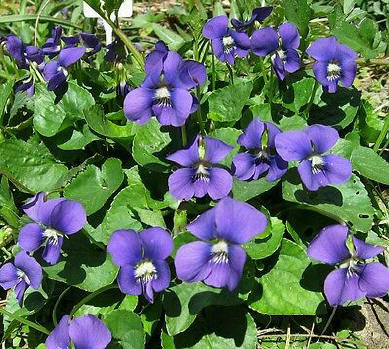
Do you love them or do you hate them? The simplest answer is that you probably love them except when they are growing in your lawn. And that happens a lot, especially if you donít get your lawn treated. Spraying your lawn to kill violets and other broadleaf plants is a questionable choice to make if you want to encourage bees and butterflies to
visit your yard. Most homeowners admire an expanse of velvety green grass that gets mowed and trimmed regularly, but it can be one of the most sterile expanses of green imaginable, wasteful and useless.
As an alternative, stop treating your yard and encourage violets to grow there, along with dandelions, yellow buttercups, and other plants that we have come to consider weeds. Violets (Viola soroia) are blooming right now. They are hardy perennials with leaves and flowers that come straight up from well-anchored roots/rhizomes to make small basal
rosettes of leaves. I once unintentionally ignored a border flower bed to find that soon the front of the border became a row of very healthy wild violets.
 These plants are native to North Americas from the Rockies to the Atlantic. Viola soroia prefers living conditions in full sun or partial shade and moist/medium soil. Hence, it is common to find them along forest roads, open woods and in lawns in the spring. The flowers will bloom
for four to six weeks. Once the temperatures get hot, above 80˚F (27˚C), the flowers generally fade and disappear.
These plants are native to North Americas from the Rockies to the Atlantic. Viola soroia prefers living conditions in full sun or partial shade and moist/medium soil. Hence, it is common to find them along forest roads, open woods and in lawns in the spring. The flowers will bloom
for four to six weeks. Once the temperatures get hot, above 80˚F (27˚C), the flowers generally fade and disappear.
The flowers and young leaves are edible and reportedly high in vitamin A and C. They can be used as garnish, in salads and making a tea. Additionally, jams and other sweetened items can be made from the flowers. Be quite sure that no herbicides or pesticides have been sprayed where you want to collect leaves or flowers that will be eaten.
The violet flower is unique in that it possesses an additional self-pollinating flower. Cleistogamy is a type of automatic self-pollination of certain plants that can propagate by using non-opening, self-pollinating flowers. Especially well known in peanuts, peas, and pansies, this behavior is most widespread in the grass family. However, the
largest genus of cleistogamous plants that will produce seeds is Viola. The seeds are thrown from the flower when the pod is breached from seed maturation or other forces acting upon it. Another way violets reproduce is that the seeds attract ants. The ants in turn carry seeds to new locations furthering their spread.
Fritillary butterfly caterpillars will eat the leaves of this plant. This includes the Diana Fritillary, Silver-bordered Fritillary and Meadow Fritillary. The small pearl-bordered fritillary (Boloria selene), called the silver-bordered fritillary in North America, is a butterfly of the family Nymphalidae. The small fritillary is found across Europe
and North America and feeds exclusively on violets in its larval stages. Fortunately, Meadow fritillaries have been spotted in Carroll and Frederick Counties in nearby Maryland. Whoís to say they havenít wandered into our areas of Pennsylvania too.
Violets are just one wild plant that can find its way to your lawn. Another is buttercup (Ranunculus acris) which has appeared in my own yard for several years. I do not consider it a weed but a wildflower and often cut the stems to make bouquets before my lawn gets mowed. Dandelions are a different story; I donít like them, but mostly theyíre too
much trouble to kill. Besides, bees need them for early spring pollen. There are also many health benefits attributed to dandelions. So leave them be.
Right now, there has been an uptick in gardening with many people buying seeds and planting gardens. Unfortunately, many of these gardens will find themselves planted in a sea of sterile green lawns. If youíve started a garden, consider how your plants will be pollinated. Has the job of bees and other pollinators become more difficult as housing
developments occupy more grasslands and treated lawns become more the norm? Are enough pollinators going to find your small vegetable or flower garden amidst all the well-manicured lawns?
It might be time to consider taking steps to make lawns more pollinator friendly. Well-maintained lawns often discourage pollinators. According to the Zerces Society, an organization committed to protecting pollinators, mowing lawns less frequently and tolerating plants such as violets, clover, dandelions and other broadleaf "weeds" that are
valuable food sources for pollinators are two measures homeowners can take to build better diversity in the landscape.
Now that the weather is becoming definitely spring-like, take advantage of the quietness surrounding us and pay attention to nature. Listen for the bees and birds. Check your yard for any unusual wild animals. Notably, I saw a red fox in my suburban neighborhood just recently. Most importantly, keep in mind the preservation of the lowly native
violet, a plant worthy of our care and attention.
Read other articles by Martie Young
Read other articles on ecological gardening & native plants